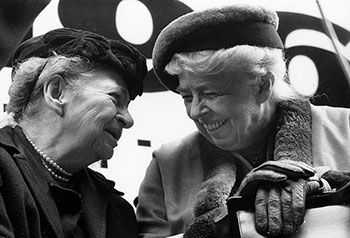There is work to be done, so we do it: the power of love and servant leadership
As 25,000+ leaders in sustainable building gather in Washington, D.C. this week, I've been reflecting on my role as Chair of the USGBC Board of Directors and also Slipstream's role in the green building movement.
Last year at Greenbuild, New York Times commentator David Brooks shared excerpts from his book The Road to Character during the closing session. That was an especially powerful talk for me. He spoke a great deal about Frances Perkins, FDR’s Secretary of Labor and the first female U.S. cabinet minister. Frances Perkins is a hero of mine as she is probably the most famous alumnus of my alma mater, Mount Holyoke College. Mount Holyoke’s mission is to prepare women for a life of purpose – to teach them leadership skills and then inspire them to deploy those skills in a life of service. And at my 30th reunion in May, the student staff were wearing T-shirts with this quote from Frances Perkins:
"It is there to be done, so I do it."

PHOTO SOURCE: The Kheel Center for Labor-Management Documentation and Archives in the ILR School at Cornell University. Creative Commons license.
Taking some liberties with this quote, “there is work to be done, so I do it” seems to me to be at the heart of the green building movement – so fueled by volunteer servant leaders. It is part of Slipstream’s culture, too, where our employees set and maintain extraordinary levels of quality as individuals and as peers. It’s the mission that fuels this commitment to the work – a mission that advances sustainable energy in buildings. A mission that stands for everyone’s right to work, learn and live in buildings that are clean, healthy, safe, and don’t threaten other life on our planet.
I’ve witnessed the “there is work to be done, so I do it” within the USGBC as it inspires efforts like the social equity pilot credit in LEED addressing child and slave labor in our supply chain, green veterans training other vets to deploy for sustainability, or our Board of Directors pushing to include biodiversity as part of our agenda or increase USGBC’s reach to the under-served. Indeed, USGBC’s most powerful instrument of market transformation—LEED—was built by tens of thousands of technical volunteer hours. Free labor by servant leaders. LEED has changed the way we buy, design and occupy buildings and created an entirely new market for sustainable materials and services. Volunteers know there is work to be done, so they do it.
I see the same ethos from our team at Slipstream – in the Friday morning meetings of the buildings team as they bring gnarly technical problems together and solve them collaboratively, or as our employees play Cool Choices in an effort to improve our own sustainable behaviors. This fall we launched Accelerate Performance to empower owners to set energy use targets and hold design teams accountable – and our team is working tirelessly with other committed partners to make this the new way thousands of owners contract for buildings. I see it in our staff volunteering to make change through ASHRAE, USGBC, AIA, AESP or the professional societies specific to their expertise, and through the volunteer hours they contribute to prairie restoration or shelter for the homeless or health causes that inspire them. Slipstream staff know there is work to be done, so they do it.
Why? Why do servant leaders take on this work leading change before the rest of the world is ready, why do they put in the time and the energy and the patience to tackle this work?
Love. I think we do this work because of love.
We don’t talk about it over our budget meetings, but I believe that love is what drives us, servant leaders, in the green building movement – which is, after all, a human rights movement.
Slipstream is a rigorous, engineering-driven culture, so whenever I make a dramatic emotional statement, I’m asked by my colleagues: “where’s your evidence for that? What’s the data?” And I thought about that – what is my evidence for love at the heart of our movement? I see it every day in what drives us.
Some of us are driven by a love of nature that was inspired by a mom or dad or grandmother or grandfather. Some of us have made a friend for life through a volunteer project. Some of us have taken a break from volunteer work, only to answer “yes” when someone asks us to give one more time. Some of us show our faith at work in the world through our work in sustainability. And sometimes it’s even more mundane than that—pushing the environmental performance and the quality of a project even after the billable hours run out - or even when no one else was asking for that extra mile for the environment.
And we would do it all again.
We are the evidence. This is what love looks like in action. This is why Slipstream has been successful. This is why the USGBC and its communities have been successful. This love in action is why, no matter what inevitable barriers to change present themselves, we will achieve our goal of sustainable energy use in buildings, and a green building for everyone within our generation.
Now. There is work to be done. So let’s do it.